ADSactly Folklore: When Giants Roamed the Earth (Part 3)
Hello again, dear @adsactly readers! In our quest to uncover the truth about the race of giants so many ancient texts mention, it is now time to turn our attention to one of the oldest source of knowledge we have at our disposal - the Bible and other writings connected to it. In the first two installments on this subject, we’ve seen that the ancient Greeks and the Norse closely associated the existence of Giants with the creation of the world, hence their presence in cosmogony myths. As we all know, the Bible is completely different in this respect, as the world with everything in it is entirely God’s creation. Yet, the Giants are mentioned as being on this Earth in ancient times, before the Flood and the subsequent rebirth of the human race from Noah and his descendants.
In various Biblical texts, the Giants are called the Nephilim, a term which is open to interpretation. In various passages, these beings are described as having an enormous stature, so the later translation of the term as ‘gigantes’ or ‘giants’ is certainly accurate. However, in itself, the Hebrew word would better be translated as the ‘fallen ones’. Fallen angels, to be more specific, who descended to Earth to take wives among the mortal females and have children with them.
Let’s see how this event is depicted in Genesis:
’ When people began to multiply on the face of the ground, and daughters were born to them, the sons of God saw that they were fair; and they took wives for themselves of all that they chose. Then the Lord said, "My spirit shall not abide in mortals forever, for they are flesh; their days shall be one hundred twenty years." The Nephilim were on the earth in those days—and also afterward—when the sons of God went in to the daughters of humans, who bore children to them. These were the heroes that were of old, warriors of renown’.
The passage is ambiguous as it is impossible to say if the term Nephilim refers to the ‘sons of God’, their progeny with mortal women or, perhaps, both.
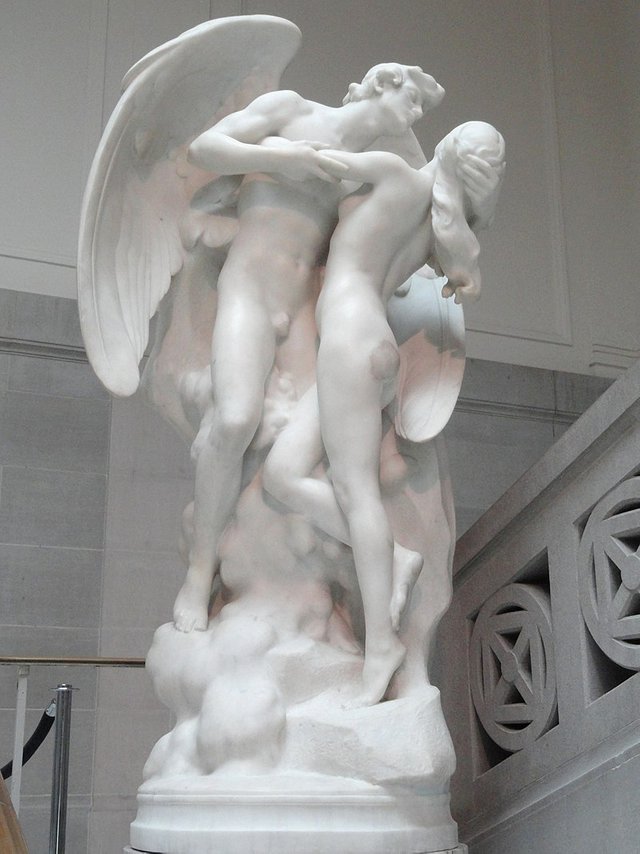
’The Sons of God Saw the Daughters of Men That They Were Fair’, sculpture by Daniel Chester French.
source
Some texts mention Samyaza, a high-ranking angel belonging to the Watchers, as the leader of the rebellious heavenly beings. ‘The Book of Giants’ a manuscript of the famous Dead Sea Scrolls found at Qumran, mentions that Samyaza had two giant sons, Ohyah and Hahyah.
Such a thing went against God’s plans and, at some point, the fallen angels were punished for their transgression and sent to a variant of Hell, except for a handful of them, some ten percent according to various interpretations, who were left on earth as demons, to tempt humans into sin.
It is interesting to observe the connection between the Giants and the idea of rebellion, which reminds us of the clashes in Greek mythology where the giants also took arms against the gods of Mount Olympus.
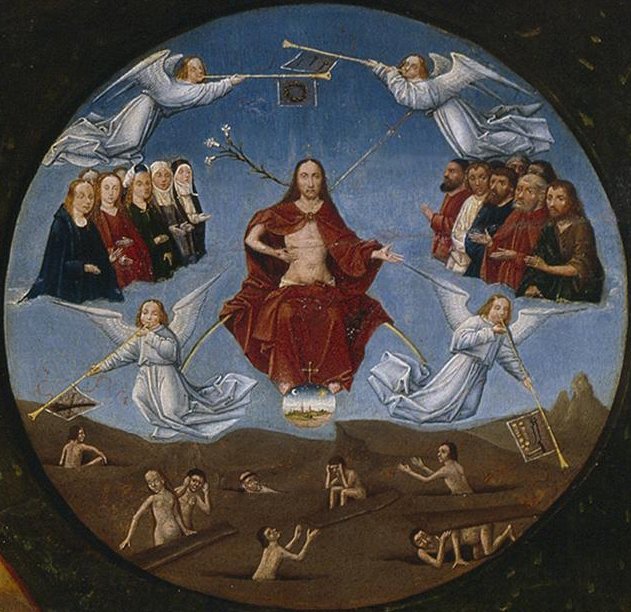
The Fall of the Rebel Angels, by Hieronymus Bosch
source
The same rebellion motif is present in another version regarding the origins of the Nephilim. Old Hebrew and Christian texts mention the possibility that the fabled giants were, in fact, descendants of Seth, the son born to Adam and Eve to replace Abel, the son killed by his brother Cain. In this variant, the sons of Seth, who were supposed to be righteous, strayed from the path and married the daughters of Cain, which, of course, had inherited their father’s evil nature and his sin. Indeed, extracanonical texts, such as the 6th century manuscript called ‘Conflict of Adam and Eve with Satan’, mention that the sons of Seth were beings of extreme purity, almost like angels, living up on the mountain, where they preserved their virginity and innocence.. until they gave in to temptation and went after Cain’s daughters. Given that the text is more recent, historically speaking, it might very well be an attempt to give an alternate explanation to the origins of the Nephilim. Describing them as being of human origin deals away with all the unpleasant implications of them being born of ‘fallen angels’, an idea which does not sit well with either Jewish or Christian tradition.
Whichever interpretation we might prefer, the Giants of old should have gone extinct after the Flood. An ancient Jewish text called ‘The Book of Jubilees’ mentions that one of the reasons God ordered the flood was to rid the Earth of the giants, who are described as violent, much as the Giants in the Norse mythology.

The giant fruits of Canaan brought back by the spies of Moses
source
Fact is the Giants did not disappear with the Great Flood, as they are mentioned in various Biblical texts clearly referencing later events.
For instance, ‘The Book of Numbers’ tells of the moment God told Moses to send 12 spies to the land of Canaan, to see if it was suitable for his people. The spies return with an amazing tale regarding the inhabitants of Canaan, which are described as fearsome giants.
’And there we saw the Nephilim, the sons of Anak, who come of the Nephilim; and we were in our own sight as grasshoppers, and so we were in their sight’.
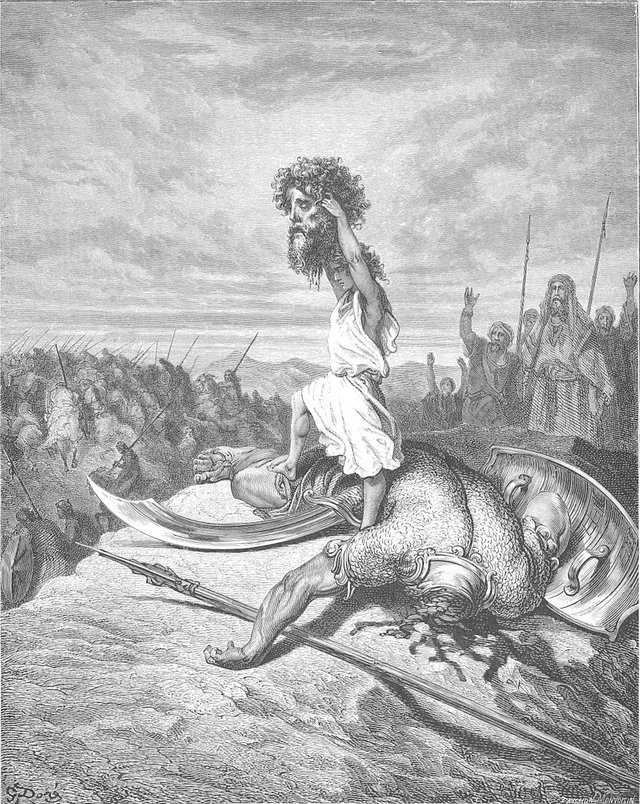
David presenting the head of the slain Goliath
source
One of the most famous Giants in Jewish lore is, of course, Goliath, the Philistine, defeated by the brave and cunning David. A fierce warrior, Goliath is described to be between two and three meters tall. Interesting to note that the David and Goliath episode closely mirrors the fragment in the Greek Iliad describing the fight between the hero Nestor and the giant Ereuthalion.
Other texts describe the Giants as being more than a mile tall.
The Anak mentioned in the quote above is the forefather of the Anakim, the Giants who lived in the area around Hebron. The Hebrew Bible describes Anak as being a Rephaite, which also means giant.
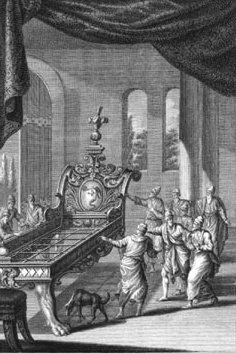
The bed of King Og
source
The Israelites were instructed by God to exterminate the race of giant people who inhabited the Canaan region. One of those is Og, king of Bashan, who was so big, his bed was over 13 feet long. As per God’s promise, Moses and his army easily defeat Og and all his giants are slain. The Jewish Talmud further embellishes the great victory against the king of Bashan by saying this Og was so huge he tried to crush the Israelites by uprooting a whole mountain with which to destroy their encampment, but God intervened and Og was trapped under the mountain.
However, most Jewish scholars agree the text should be read metaphorically. Depicting their enemies as larger than life is a good method of glorifying the ancestors’ deeds.
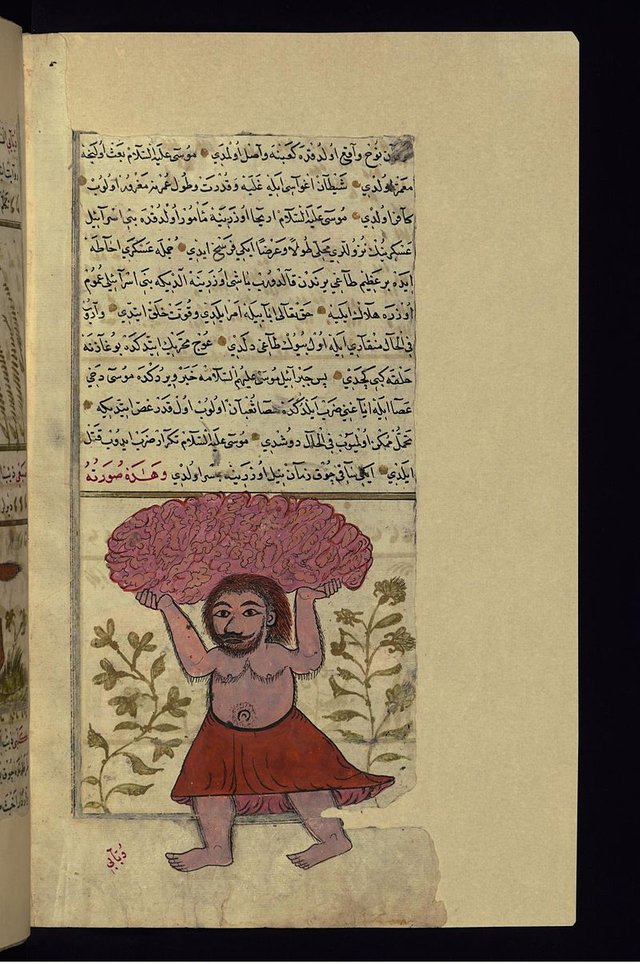
Arab manuscript depicting Og carrying a mountain
source
The figure of Og can be found in the Islamic tradition as well. Here there is a famous description of the giant fishing and frying whales while standing in the ocean, with the water only reaching up to his knees.
Much later, this mysterious figure appears in the ‘Book of Giants’. There, Ogias is described as fighting a great dragon, a motif present in many folk tales.
Even if we are no closer to establishing who these mysterious Giants might have been, historically speaking, at least the description of their race in Biblical texts, canonical or not, only consolidates what we have learned from other mythologies - the Giants were evil, sinful and violent and had to be destroyed.
Post authored by @ladyrebecca.
References: 1, 2, 3.
Click on the coin to join our Discord Chat

Witness proposal is here:
Go To Steem Witness Page
In the bottom of the page type: adsactly-witness and press vote.

Use small letters and no "@" sign. Or, click here to vote directly!
Thank you!
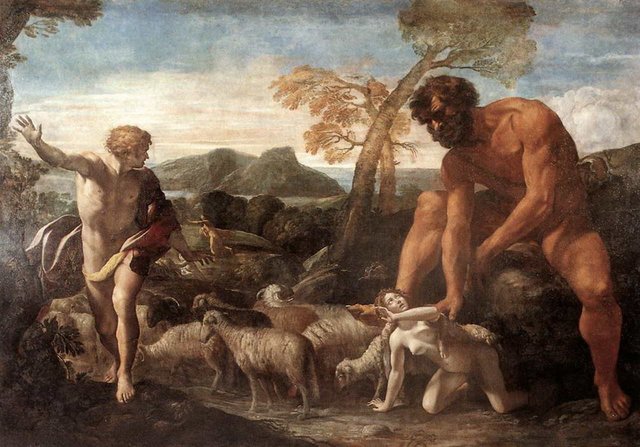
Giant can be interpreted metaphorically or real.
In a metaphorical understanding, the giant can be interpreted as a form of the nature of people who rely on their power and power to do bad things. However, not all badness is bad for others. For example, someone who defends the poor by stealing the wealth of rich and despotic people. for people who are stolen, of course this is a bad deed, but for people who are helped he will assume that the stealing he is doing is good.
in the war between goliath and David, goliath is considered a giant.
Especially if it is associated with the writing of religious doctrine, of course the one who is made a hero is David. Likewise in the writing of the Ramayana story, the giant told is a supporter of Ravana. while the rama and his relatives were made as knight figures.
Beyond that, we all know there are ancient human fossils. In Java, Indonesia has fossils of Megantropus paleojavanicus. This fossil is stored in the Sangiran museum. From existing fossils we can imagine that these early humans had a very large size.
this could also be called a giant bone.
Thank you @ladyrebecca
Thank you @adsactly
thank you Steemit
Warm regard from Indonesia
@ladyrebecca, Not just Scriptures, if we see the Ancient Monuments and Scultupres then no one can deny that these giants were existed but in my opinion one thing may be always be a mystery and that is, what giants did? And they were enemies of Human Beings?
Truth always rises as we never expected. Stay blessed.
Posted using Partiko Android
Congratulations! Your post has been selected as a daily Steemit truffle! It is listed on rank 25 of all contributions awarded today. You can find the TOP DAILY TRUFFLE PICKS HERE.
I upvoted your contribution because to my mind your post is at least 21 SBD worth and should receive 534 votes. It's now up to the lovely Steemit community to make this come true.
I am
TrufflePig, an Artificial Intelligence Bot that helps minnows and content curators using Machine Learning. If you are curious how I select content, you can find an explanation here!Have a nice day and sincerely yours,

TrufflePigThe existence of the giants will always be, like many other things, a component of the enigmatic human culture, because it is part of the mythology, and as such, it does not make sense to question it scientifically, since we would be mixing knowledge of different statuses.
If there were some humans of uncommon stature, as manifested by fossils found, it seems to me irrelevant to assess the issue at hand.
I have read the Biblical Old Testament not as a specialist (of course in versions translated into my mother tongue: Spanish) and I don't remember mentioning a giant before Goliath; the closest would be Goliath. But, as someone says, the figure of the "giant" would not be a metaphor for excessive power. I remember that in Mayan mythology, a community kills a character called Zipacná for this boasting of his enormous strength (the equivalent of Greek excess -hybris-).
There is in Sumerian literature an interesting precedent in the Epopee of Gilgamesh.
Thank you for your interesting post, @ladyrebecca.
This is getting better with every post.
I agree with most scholars that "the text should be read metaphorically."
Otherwise, what difference might there be between so-called sacred texts and folklore/myth or fiction?
The fascinating thing about a close reading of the different religions is how similar they all are. As you have shown here and in the previous posts, there are many affinities and it is in these commonalities that peoples of the world should find common ground to solve their differences, gigantic, as they may seem.
I was fascinated with the amount of legends and myths that there are in Europe about giants, and especially, about the belief that they came from fallen angels. From the Bible, as you well point out, I only remember hearing about Goliath. In many of the stories I have read, the giants are extraordinary beings, with superhuman strength and in some cases, are considered stupid, clumsy and even weak. This representation, perhaps, has been generalized, to take away part of that power or deification of these primitive creatures. Enchanted with this series that you have been able to develop and that has turned out to be extremely interesting and unique for me, @ladyrebecca.